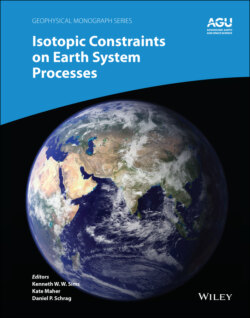Читать книгу Isotopic Constraints on Earth System Processes - Группа авторов - Страница 71
3.3. RESULTS
ОглавлениеAll but one of the studied samples have δ44Ca values that are similar to the “normal” BSE composition (~0‰); see Fig. 3.3 and Table 3.1. Their calcium isotopic compositions are similar to the compositions of clinopyroxene‐rich and/or unmelted and unmetasomatized peridotites (Huang et al., 2010; Kang et al., 2017; Simon & DePaolo, 2010) and well‐studied oceanic and continental basalts, e.g., Bermingham et al. (2018), Huang et al. (2011), Simon and DePaolo (2010), and Simon et al. (2017), Table 3.1. Honduran sample YO‐1, which has MORB‐like Sr and Nd isotope and LILE/HFSE trace element ratios, exhibits a δ44Ca (–0.16 ± 0.14‰ [2σ]) that is similar to the samples from Nicaragua, TE1 (δ44Ca = –0.12 ± 0.14‰ [2σ]) and SC2 (δ44Ca = 0.06 ± 0.05‰ [2σ]) that have the most obvious trace element and radiogenic isotope signatures for sediment subduction (Fig. 3.4; Carr et al., 1990; Patino et al., 2000). The final Central American arc sample from Guatemala exhibits a similar calcium isotopic composition (δ44Ca = –0.08 ± 0.14‰ [2σ]). Likewise, both fresh Oldoinyo Lengai carbonatites OL lava 2007 (δ44Ca –0.13 ± 0.14‰ [2σ]) and OL Lava 4‐7‐08 (δ44Ca = 0.05 ± 0.13‰ [2σ]) have calcium isotope compositions that are similar to BSE. The exception in this study is the clast of intrusive carbonatite from the Laacher See volcano. The carbonatitic ejecta clast has a value that is lighter than BSE (δ44Ca = –0.39 ± 0.14‰ [2σ]).
Figure 3.3 Calcium isotopic composition of Central American volcanic arc magmas (this study), extrusive Oldoinyo Lengai carbonatite lavas (this study), and intrusive Laacher See carbonatite clast (this study). Values for unmelted/unmetamorphosed peridotites, komatiites, terrestrial basalts, seawater, marine carbonates, SRM915a carbonate, and the effect of metasomatism shown for reference (Amsellem et al., 2019; Antonelli et al. 2019a; Bermingham et al., 2018; Fantle & DePaolo, 2005; Huang et al., 2010, 2011; Ionov et al., 2019; Kang et al., 2017; Simon & DePaolo, 2010; Simon et al., 2017). Not shown are the Precambrian carbonate data of Blattler and Higgins (2017) that exhibit an average δ44Ca that is indistinguishable from BSE calcium isotope composition.
